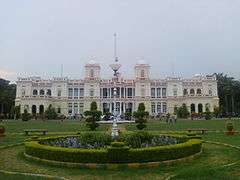Balaji Prakash
Balaji Prakash (born 1968) is an Indian structural biologist, biochemist and the senior principal scientist and the head of the department of molecular nutrition of the Central Food Technological Research Institute. Known for elucidating the structure of a unique GTP-binding protein, Prakash is an elected fellow of the National Academy of Sciences, India. The Department of Biotechnology of the Government of India awarded him the National Bioscience Award for Career Development, one of the highest Indian science awards, for his contributions to biosciences, in 2009.
Balaji Prakash | |
|---|---|
| Born | 1968 India |
| Nationality | Indian |
| Alma mater | |
| Known for | Studies on GTP-binding protein |
| Awards |
|
| Scientific career | |
| Fields | |
| Institutions | |
Biography

Balaji Prakash, born in 1968,[1] did his doctoral studies at the Indian Institute of Science and after securing a PhD in 1996, he completed his post-doctoral work at Max Planck Institute of Molecular Physiology in 2002.[2] Returning to India, he joined Jawaharlal Nehru University the same year as an assistant professor at the Special Center for Molecular Medicine but his stay there lasted only 7 months.[3] In November 2002, he joined the Indian Institute of Technology, Kanpur at their Department of Biological Sciences and Bio-Engineering where he later served as an associate professor from 2005 to 2010 and as a professor from 2010 to 2014. It was at this time, he took a long leave from the institute[4] to join the Department of Molecular Nutrition of the Central Food Technological Research Institute as a senior principal scientist, a position he holds to date.[5] He also serves as a CSIR recognized faculty at the Academy of Scientific and Innovative Research.[6]
Career
Prakash's research focus is on enzyme catalysis, with special interest in the enzyme family composed of GTPases, kinases and sugar nucleotidyltransferases, as well as the development of peptides for food industry.[5] During his post-doctoral work at the Max Planck Institute of Molecular Physiology, he elucidated the structure of a GTP-binding protein.[4] At CFTRI, he has worked on molecular nutrition and the development of nutraceuticals and has developed a technology titled Microbes based printing for fabrication of electronic circuits for which he holds the patent; another of his invention, A novel device for crystallizing proteins and protein complexes or other biological macromolecules, is being prepared for patent submission.[3] His studies have been documented by way of a number of articles[7][note 1] and ResearchGate, an online repository of scientific articles has listed 55 of them.[8] Besides, he has delivered invited speeches at seminars including the 2nd Indo-American Frontiers of Science Symposium held at Irvine, California in 2006 and was a senior research fellow of the Wellcome Trust in 2004.[5]
Awards and honors
The Department of Biotechnology (DBT) of the Government of India awarded him the National Bioscience Award for Career Development, one of the highest Indian science awards in 2009.[9] In 2011, he was elected as a member of the Guha Research Conference[5] and the National Academy of Sciences, Indiaelected him as a fellow in 2013.[10]
Selected bibliography
- Vishweshwaraiah, Yashavanth L.; Prakash, Balaji; Gowda, Lalitha R. (2018). "Expression profiling of the Dolichos lablab lectin during germination and development of the seed". Plant Physiology and Biochemistry. 124: 10–19. doi:10.1016/j.plaphy.2017.12.040. PMID 29324242.
- Bais, Vaibhav Singh; Mohapatra, Balaram; Ahamad, Nadim; Boggaram, Sanjana; Verma, Sandeep; Prakash, Balaji (2018). "Investigating the inhibitory potential of 2-Aminopurine metal complexes against serine/threonine protein kinases from Mycobacterium tuberculosis". Tuberculosis. 108: 47–55. doi:10.1016/j.tube.2017.10.005. PMID 29523327.
- Vithani, Neha; Batra, Sahil; Prakash, Balaji; Nair, Nisanth N. (6 January 2017). "Elucidating the GTP Hydrolysis Mechanism in FeoB: A Hydrophobic Amino-Acid Substituted GTPase". ACS Catalysis. 7 (1): 902–906. doi:10.1021/acscatal.6b03365.
See also
- Bowman–Birk protease inhibitor
- Dolichos lablab
Notes
- Please see Selected bibliography section
References
- "NASI fellows". National Academy of Sciences, India. 12 January 2018. Retrieved 12 January 2018.
- "Structural Biology lab". home.iitk.ac.in. 21 January 2018. Retrieved 21 January 2018.
- "Link to Lab Webpage". IIT Kanpur. 21 January 2018. Archived from the original on 22 January 2018. Retrieved 21 January 2018.
- Ailza (21 January 2018). "BSBE Faculty". www.iitk.ac.in. Retrieved 21 January 2018.
- "Faculty profile". www.cftri.com. 21 January 2018. Retrieved 21 January 2018.
- "AcSIR – Academy of Scientific & Innovative Research – Faculty List". acsir.res.in. 21 January 2018. Retrieved 21 January 2018.
- "On Google Scholar". Google Scholar. 20 January 2018. Retrieved 20 January 2018.
- "On ResearchGate". On ResearchGate. 20 January 2018. Retrieved 20 January 2018.
- "Awardees of National Bioscience Awards for Career Development" (PDF). Department of Biotechnology. 2016. Retrieved 20 November 2017.
- "NASI Year Book 2015" (PDF). National Academy of Sciences, India. 12 January 2018. Retrieved 12 January 2018.
External links
- "OSDD - relevance of computational methods" (video). YouTube. 19 September 2012. Retrieved 20 January 2018.